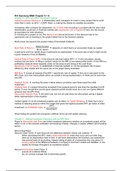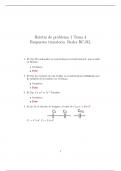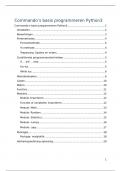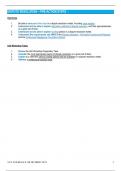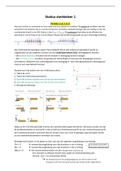IFA Summary BMA Chapter 5 + 6:
Chapter 5 – NPV and Other Investment Criteria
Capital Investment Decisions shareholders want managers to invest in every project that is worth
more than it costs, so NPV > 0 (NPV Rule) making the shares as valuable as possible.
Companies often compare the (expected) rate of return from investing in a project with the return that
shareholders could earn in financial markets (the opportunity cost of capital) here, the risk should
be equivalent for both situations.
In choosing for a project or not, the discount rate should be known this discount rate is the
opportunity cost of investing in the project rather than in the financial markets.
Stock prices are equal to the present value of forecasted dividends.
Book Income
Book Rate of Return = depends on which items an accountant treats as capital
Book Assets
investments and how rapidly these investments are depreciated the book rate of return might not be
a good measure of true profitability.
Internal Rate of Return (IRR) the discount rate that makes NPV = 0 this calculation usually
involves trial and error filling in random values for the IRR (r) and seeing what works this IRR is a
profitability measure which depends solely on the amount and timing of the cash flows.
Opportunity Cost of Capital established in financial markets it is the expected rate of return
offered by other assets with the same risk as the project being evaluated.
IRR Rule accept all projects if the IRR > opportunity cost of capital this rule is equivalent to the
NPV Rule, but it has many pitfalls which can create a wrong representation there can be more than
one IRR.
Payback Period counting the years it takes before cumulative cash flows equal the initial
investment.
Payback Rule a project should be accepted if the payback period is less than the specified cut-off
period even though this sounds good, payback period should never be a rule, as it gives different
answers than the NPV Rule.
Discounted Payback Rule the same rule, but now all cash flows are discounted, giving a slightly
better representation of the situation.
Limited capital not all investment projects can be taken Capital Rationing there has to be a
method of selecting projects within the budget that gives the highest possible NPV per dollar of initial
NPV
investment Profitability Index .
Investment
When finding the perfect set of projects is difficult, firms use soft capital rationing.
Chapter 6 – Making Investment Decisions with the NPV Rule
Project’s discounted cash flows and initial investment determine whether an investment project will be
taken or not this requires estimation and tracking of taxes, changes in capital, inflation and investing
period.
Discounting Rules:
Discount Cash Flows cash flows are the difference between inflows and outflows
- When calculating the NPV, state capital expenditures when they occur and not when they
show up as depreciation later in time add back depreciation and subtract cap expenditure.
- Use accrual basis of accounting, thereby taking all parts of a transaction into one period
working capital is the difference between a company’s short-term assets and liabilities this
capital can change throughout an investment project.
Discount Incremental Cash Flows
- Include all incidental effects.
- Do not confuse average with incremental payoffs.
Chapter 5 – NPV and Other Investment Criteria
Capital Investment Decisions shareholders want managers to invest in every project that is worth
more than it costs, so NPV > 0 (NPV Rule) making the shares as valuable as possible.
Companies often compare the (expected) rate of return from investing in a project with the return that
shareholders could earn in financial markets (the opportunity cost of capital) here, the risk should
be equivalent for both situations.
In choosing for a project or not, the discount rate should be known this discount rate is the
opportunity cost of investing in the project rather than in the financial markets.
Stock prices are equal to the present value of forecasted dividends.
Book Income
Book Rate of Return = depends on which items an accountant treats as capital
Book Assets
investments and how rapidly these investments are depreciated the book rate of return might not be
a good measure of true profitability.
Internal Rate of Return (IRR) the discount rate that makes NPV = 0 this calculation usually
involves trial and error filling in random values for the IRR (r) and seeing what works this IRR is a
profitability measure which depends solely on the amount and timing of the cash flows.
Opportunity Cost of Capital established in financial markets it is the expected rate of return
offered by other assets with the same risk as the project being evaluated.
IRR Rule accept all projects if the IRR > opportunity cost of capital this rule is equivalent to the
NPV Rule, but it has many pitfalls which can create a wrong representation there can be more than
one IRR.
Payback Period counting the years it takes before cumulative cash flows equal the initial
investment.
Payback Rule a project should be accepted if the payback period is less than the specified cut-off
period even though this sounds good, payback period should never be a rule, as it gives different
answers than the NPV Rule.
Discounted Payback Rule the same rule, but now all cash flows are discounted, giving a slightly
better representation of the situation.
Limited capital not all investment projects can be taken Capital Rationing there has to be a
method of selecting projects within the budget that gives the highest possible NPV per dollar of initial
NPV
investment Profitability Index .
Investment
When finding the perfect set of projects is difficult, firms use soft capital rationing.
Chapter 6 – Making Investment Decisions with the NPV Rule
Project’s discounted cash flows and initial investment determine whether an investment project will be
taken or not this requires estimation and tracking of taxes, changes in capital, inflation and investing
period.
Discounting Rules:
Discount Cash Flows cash flows are the difference between inflows and outflows
- When calculating the NPV, state capital expenditures when they occur and not when they
show up as depreciation later in time add back depreciation and subtract cap expenditure.
- Use accrual basis of accounting, thereby taking all parts of a transaction into one period
working capital is the difference between a company’s short-term assets and liabilities this
capital can change throughout an investment project.
Discount Incremental Cash Flows
- Include all incidental effects.
- Do not confuse average with incremental payoffs.

